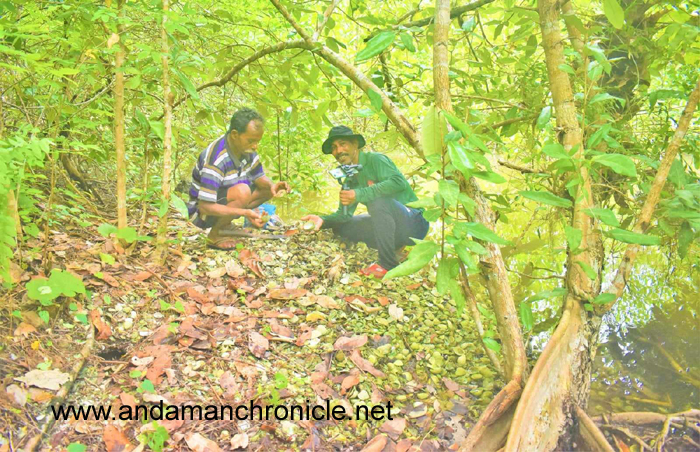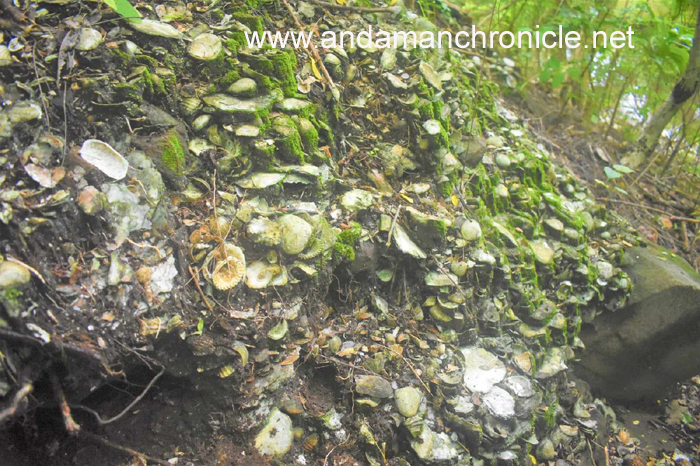The New Discovery Comes Three Decades After Dr. Zarine Cooper Had Discovered Chouldari Midden

Report by Denis Giles:
Under a long term project on the human settlement on the Andaman Islands between 1989 and mid 90s, cave sites and shell-middens including a shell-midden at Chouldari were examined by Dr. Zarine Cooper, a Pune based archaeologist and evidence indicates that the Islands were settled well over 2000 years ago and all the main islands have traces of ancient habitation.
The area name Sippi Tekri in Middle Andaman is based on a large kitchen-midden or shell-midden. After Zarine Cooper no one has yet made any attempt to pay visit to such known and unknown middens and document the same. Such sites are rich in pottery, faunal remains and in stone and bone artefacts.
At the Chouldari site, the tall, 2000-year-old mound yielded, in the earlier phase of occupation, molluscan species belonging to rocky shores and estuaries, whereas at a later stage the mud flats in the littoral and sublittoral zones were increasingly exploited. The species of bivalves included Marcia Recens, Anadara Granosa and Scapharca (Cunearca) Congrua (Cooper 1990). The chemical and mineral analysis of soil from this site, as also the X-ray diffraction studies of shells, revealed a period of abandonment spanning several centuries.
As a good news with all excitements for all the islanders and as a matter of pride for all, an island born researcher Dr. Pronob Kumar Sircar with his team has discovered a hitherto unseen shell-midden in the deep rainforest between Port Mouat and Hobdaypur of South Andaman.
Dr Sircar on our contact mentioned that he discovered and explored a huge shell-midden with an approximate height of 5-6 meters for the first time in the region out of Chouldari in South Andaman. He visited the site on 7th July 2023. From the analyses of its geographical location and historical events of the recent past, it is concluded by Dr. Sircar that the site is located in the midst of the forests of South Andaman near a creek. After the Tsunami of 2004, the edge of the mound has been approached by creek waters.

Sircar, renowned historian and anthropologist of the Islands on interrogation by Andaman Chronicle states that the bay at Port Mouat area was approved by Lord Canning to be named Port Mouat but the Great Andamanese arrived to occupy the place thousands of years ago. He further stated that this exploration is significant in the context that after the return of Doodnath Tiwari (who played a key role in Battle of Aberdeen). Doodnath Tiwari explained to Dr Walker (stated on 26 May 1859 at Page 2 of copy of his statement) that he had visited Port Mouat on several occasions. So probably he visited this camp site too during 1858-59 when he was staying and wandering with the Great Andamanese in the region.
Sircar further continued to say about the significance of the location that the discovered shell-midden is few kilometers away from Mount Augusta and the Andaman history has it that during the month of May 1866, Homfray moved the Andaman Home from Ross Island to the new settlement at Port Mouat. The first Home was built on the shore, a little westward of Mount Augusta. Homfray lived there for some time. In 1868, Col. Man decided to establish an orphanage and Homes at Mount Augusta for the Andamanese.
Looking to the huge size of the discovered mound, Dr Sircar comes on the conclusion that the camp-site was one of the main inhabited areas of the Great Andamanese. He further says that a future research with a scientific methodology will throw more light on this new discovery.